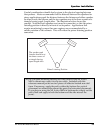
About the M1 Active Mk2
12 M1 Active Reference Manual
THE M1 ACTIVE MK2 BI-AMPLIFIERS & ELECTRONIC
CROSSOVERS
The M1 Active Mk2 uses a 75W woofer amp and a 25W tweeter amp along
with 4
th
order high and low pass electronic crossover filters centered at
2000Hz. Electronic crossovers, which separate the frequencies before being
sent to the amplifiers, have fewer phase problems and less power loss than
the traditional passive crossover used after the amplifier. Fourth-order filters
are steep (24 dB per octave), which minimizes the interaction between woofer
and tweeter near the crossover point. Additionally, the high pass (tweeter)
section of this system employs an electronic time alignment circuit. Thus the
“launch” of frequencies from both the woofer and the tweeter will originate
at exactly the same time.
There are several advantages to using built-in amplifiers and active
(electronic) crossovers versus a passive network system, most of which have
been previously enumerated in Vance Dickason’s “Loudspeaker Design
Cookbook”:
• Lower intermodulation distortion due to amplifier operation over a more
narrow bandwidth. Also, clipping caused by low frequency overload is
reduced, being limited to only one driver within a two driver system.
• Increased dynamic range. The M1 Active Mk2’s 75W and 25W amplifiers
in their bi-amp setup will clip at about the same levels as one 200W
amplifier operating into a passive crossover.
• Improved transient response.
• Better amplifier/speaker coupling for woofers.
• Better crossover performance working into a constant impedance load.
• Better subjective sound quality than high level (passive) networks.
• Easier control over driver sensitivity differences.
• Easier manipulation of phase, time delay, resonance, and various kinds of
shaping, contouring and equalization.
• Specifically in the case of the M1 Active Mk2, the wide, mid-frequency
polar response of the tweeter can be utilized down to a low 2000 Hz
thereby mating more cohesively with the 6.5" non-woven carbon fiber
(NWCF) woofer. This low crossover point is only possible through the use
of a steep, electronic fourth-order (24 dB per octave rolloff) high pass filter.


















